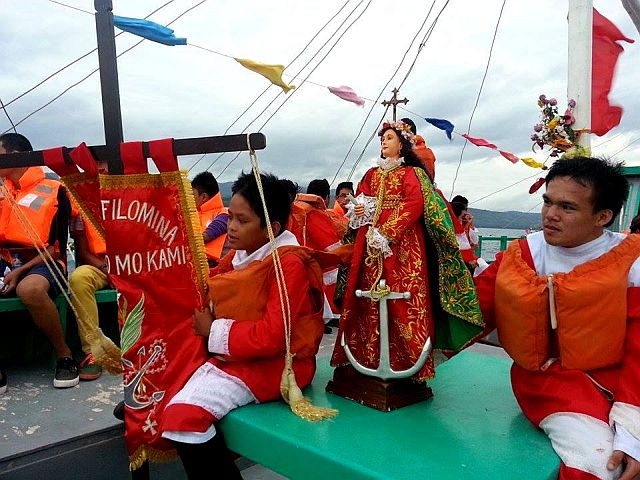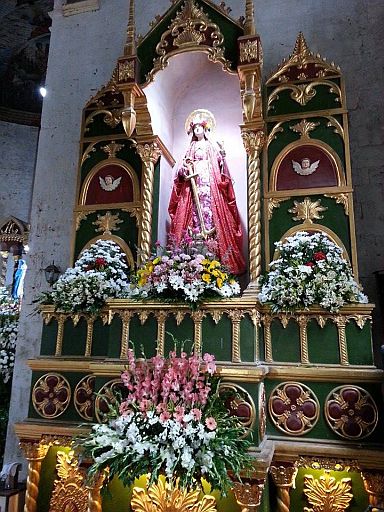
WONDER WORKER. The image of St. Filomena on board the sea vessel for the religious activity. There are no concrete historical accounts, but according to storied apparitions, Filomena (or Philomena) was born to a royal family. She was a 13-year-old girl who was tortured when she refused to renounce Christ and refused to marry a pagan emperor. Her prominent attributes are an arrow and an anchor tied around her neck, emblems of her bravery. (CDN PHOTO/CLINT HOLTON POTESTAS)
I FORECASTED the horizons like Atom Araullo—partly cloudy with a chance of rain showers.
“I’m just glad I didn’t wear high heels today,” Mother whispered after she walked past the makeshift foot plank that bridged the dock and the motorboat we embarked on. It wobbled above the roar of surf below; the strong gale from neighboring Bohol invigorated the ripple’s force. But if qualified by what the congregation pleaded for in the first three days of August, God was among the throng.
Or else, had it rained terribly hours before we drove four towns south from where we lived, Mother would have opted — perhaps, with the same enthusiasm for her choice of footwear—for the mud boots to the fluvial procession in veneration of St. Filomena, the secondary patron of the Our Lady of Pilar Parish in Sibonga.
On a carriage, her image was brought from the church to the adjacent harbor where ornamented motorboats of the participants anchored. She was perched in the middle of the sea vessel that led the religious fleet, escorted by lay ministers, the medical team, police officers and young altar servers.
Under gloomy skies but without weather threats, it sailed at 5 a.m., completing a full navigation between both territorial margins, Abogon in the north and Simala in the south.
“We asked St. Filomena’s intercession for a good weather, and God granted our prayers,” Rev. Fr. Mike Hisoler, Sibonga parish priest, revealed.

HIGH ABOVE. The new retablo of St. Filomena inside the Our Lady
of Pilar Parish in Sibonga. (CDN PHOTO/CLINT HOLTON POTESTAS)
According to him, this year’s ritual at sea is specifically devoted to the virgin martyr’s miraculous guard against storm surges and tidal waves. The foot procession later in the afternoon trailed a new route along the creek where the flood that inundated their houses on December 29, 2014 began.
A ritual inherited from my hometown’s forefathers, this commemoration is observed every Aug. 9 and 10 with higher festive spirits compared to the Our Lady of Pilar’s in October, which signified a wider cult of faithful.
Threads of theories uprooted from oral traditions. My seatmate narrated about an apparition of St. Filomena during the Japanese invasion in the Philippines at the same pier where we assembled. Since the vision occurred, witnesses initiated devotional exercises such as the novena, parades and processions, which are still alive at present. A native of the town, my late father, who never spoke about religion to me, spared this story he retold from his grandparents: the vanishing St. Filomena’s icon kept inside the convent would return with vines of amor seco tangled at her feet—evidence that she roamed and visited those remote households consecrated to her intervention.
“Mine is only a conjecture, too,” Hisoler continued. “Before, we were only a chapel under Car-Car (St. Catherine of Alexandria parish). Our parish was erected in either 1827 or 1830 with the Our Lady of Pilar as patroness, according to our records. In between those years, Filomena’s fame in Rome was increasing because of numerous miracles. I presume, since the first parish priest here was an Augustinian, he might have the opportunity to study in Rome, so he must’ve been touched by the strong devotion of the people because she was called ‘the wonder worker.’”

SEA OF BELIEVERS. As a gesture of devotion, fishermen decorated their boats and offered free ride
to the participants. The Sibonga Coast Guard required all
of them to wear life vests as a precautionary measure. (CDN PHOTO/CLINT HOLTON POTESTAS)
On the other hand, due to blurred biological lineage despite testimonies of cures including the terminal illness of St. John Vianney, the Vatican has disengaged Filomena from the Roman Martyrology or the list of saints. Rev. Fr. Ralph Argoncillo of the Our Lady of the Sacred Heart Parish in Cebu City explained that the Holy See has ordered to remove the name of Filomena, even in the local calendars, after arguments presented by scholars, whose interest had been focused on the phenomenon in connection with the revelations of Sister Maria Luisa di Gesù about the martyr’s identity.
“It’s very difficult to take that away from the people because the devotion has been embedded in their minds and in their culture,” Argoncillo commented, referring to the annual festivities in Sibonga and Alcantara.
“But it’s not a sin to venerate her because we are not praying to trees or to animals; she has been declared saint, and the only issue is the authenticity. In fact, in Greece also, it’s a big celebration.”

